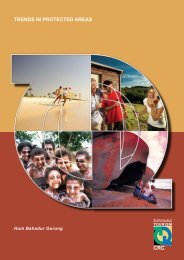icolls - Sustainable Tourism CRC
icolls - Sustainable Tourism CRC
icolls - Sustainable Tourism CRC
You also want an ePaper? Increase the reach of your titles
YUMPU automatically turns print PDFs into web optimized ePapers that Google loves.
ECOLOGY, THREATS AND MANAGEMENT OPTIONS FOR SMALL ESTUARIES AND ICOLLS<br />
range of community patterns evident between estuaries emphasises the importance, where feasible, of managing<br />
them on an individual basis.<br />
Title of paper: Tidal Inlets: their response to natural and anthropogenic changes<br />
Author: Chris Voisey<br />
Author's email: chris.voisey@epa.qld.gov.au<br />
Abstract: The interface between an estuary and the open ocean is a dynamic and complex system which<br />
influences estuarine processes and is influenced by estuarine processes. In order to gain a better understanding of<br />
this system a Moveable Bed Physical model was constructed and tested by the <strong>CRC</strong> for Coastal Zone, Estuary<br />
and Waterway Management to look at the characteristics of ebb delta growth and response for two different tidal<br />
conditions and the influence of artificial sand bypassing in a trained tidal inlet. Southport Seaway and the Tweed<br />
River Entrance are two examples where artificial sand bypassing methods are employed. Using observations<br />
from the model research and the current state of understanding in tidal inlet processes this paper will discuss the<br />
expected implications of natural and anthropogenic changes to tidal inlet systems.<br />
Title of paper: A preliminary survey of estuaries in northeast coast of Tamilnadu, India, with particular<br />
reference to plankton and water quality<br />
Author: Elayaraja Paramu<br />
Author's email: elayakals@sify.com<br />
Abstract: Problems associated with increasing pollution of estuarine systems have stimulated many<br />
investigators to examine the spatial and temporal patterns of water quality and biodiversity of these water bodies.<br />
Plankton contributes about 95% of the productivity of the marine system and forms the basis of the aquatic food<br />
chain. Ecological factors can affect the physiology of an organism and can regulate their distribution over space<br />
and time. Ecological observations were carried out in five estuaries of Northeast coast of Tamilnadu (between N<br />
13o27’34.4” to N 12o56’15.5” and E 80o18’30.0” to E 80o 05’10.4”) from July 2002 to June 2003. Surface<br />
water temperature of these systems depended on the atmospheric temperature with an exception at Ennore,<br />
where the coolant water of a thermal power plant increased the temperature up to 34oC. Salinity was seasonal<br />
and monsoon regulated. While the dissolved oxygen varied from below detectable level (BDL) to 5.3 ml. L-1.<br />
Chlorophyll a which depended on the nutrient loading could be an indicator of eutrophication and pollution.<br />
Nutrient loading was mainly from the point sources. Phytoplankton formed blooms during the periods of higher<br />
nutrient concentrations. Spirulina laxssima, Microcystis flos aquae, Asterionella glacialis and Oscillatoria<br />
limosa were the major bloom forming species. The zooplankton were dominated by the copepods in their species<br />
richness and occurrence, while the tintinnids were more in species. The rotifers were dominated by Brachionus<br />
plicatilis in abundance (up to 16,300 individuals. L-1). An herpacticoid copepod was prominent in waters with<br />
higher temperatures and they could be the best indicators of thermal pollution.<br />
Title of paper: Mouth closures and ephemeral streams: The variable hydrology of intermittent estuaries and<br />
implications for seagrass<br />
Author: Adam J. Pope, John E. Sherwood & Peter G. Fairweather<br />
Author's email: adamp@deakin.edu.au<br />
Abstract: Many temperate estuaries are not only intermittently open and closed but also have an intermittent<br />
freshwater input. These systems, often overlooked due to their size, can have large hydrological variability over<br />
medium-term time scales. This variability presents potential difficulties for estuarine species and requires a well<br />
considered approach by managers. This is particularly true where anthropogenic alterations to freshwater flows<br />
can cause large deviations from natural patterns of tidal influence and inundation of habitat. Influences of natural<br />
and hydrologic variability on seagrasses were examined in two central Victorian estuaries with intermittent<br />
freshwater flow and mouth openings. Hydrological changes during the three year study were affected by the<br />
ending of a drought and a major flood a year later as well as by anthropogenic flow reduction and augmentation.<br />
These anthropogenic influences on hydrology were compared with responses of seagrasses to overall hydrologic<br />
regimes. Such influences and responses change both seasonally and in response to climactic events. This<br />
combination of predictable and stochastic variability is considered in the context of management of such<br />
estuaries.<br />
Title of paper: A numerical model of autotrophic growth in a seagrass dominated ICOLL – the impact of<br />
different opening regimes<br />
Author: Jason Everett, Dr. Mark Baird, Assoc. Prof. Iain Suthers<br />
Author's email: Jason.Everett@student.unsw.edu.au<br />
Abstract: Opening regimes are an important factor in the overall health of intermittently open and closed<br />
lakes/lagoons (ICOLLs), impacting upon flushing time, nutrient and plankton dynamics, turbidity, water depth<br />
60











